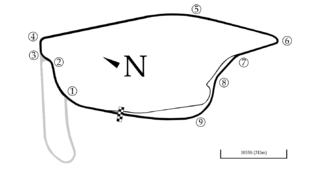
Pukekohe Park Raceway was a former FIA Grade 3 car racing track that was situated on the outside of the Pukekohe Park Thoroughbred Racetrack, located in the surrounds of Pukekohe.
The Lotus 39 was a single-seat racing car produced by Team Lotus. It was originally intended for use in Formula One, to be powered by the Coventry Climax 1.5 litre flat-16 engine. The engine project fell through and the chassis was modified to accept a Climax 2.5 litre engine for the 1966 Tasman Series, in which Jim Clark finished in third place.
Graeme Harry Lawrence is a race car driver from New Zealand. He started serious motor racing in the National 1.5 litre series winning the series decisively in 1968 ahead of David Oxton and Ken Smith. Lawrence then ran half a European F2 series in an uncompetitive semi works F2 McLaren, he found the racing harder than expected and was shaken, by his experience racing in Germany at the Hockenheim race in the rain, were Jim Clark was killed. McLaren allowed Lawrence to build up another F2 chassis in his works and was 2nd in the SR Gold Star series in the car, and first ST driver home in the Tasman races at Pukekohe and Levin.
The 1964 Tasman Series was an international motor racing series contested in New Zealand and Australia over eight races beginning on 4 January and ending on 2 March. It was the first Tasman Series. The series, which was officially known as the Tasman Championship for Drivers, was organised jointly by the Association of New Zealand Car Clubs Inc. and the Confederation of Australian Motor Sport with the winning driver awarded the Tasman Cup. The championship was open to racing cars using unsupercharged engines of up to 2,500 c.c. capacity.

The New Zealand Grand Prix, sometimes known as the New Zealand International Grand Prix, is an annual motor racing event held in New Zealand. First held in 1950, it is best known for hosting rounds of the Tasman Series in the 1960s and 1970s. It is currently run as the signature race of the Formula Regional Oceania Championship.

The Longford Circuit was a temporary motor racing course laid out on public roads at Longford, 23-kilometre (14 mi) south-west of Launceston in Tasmania, Australia. It was located on the northern edges of the town and its 7.242 km (4.500 mi) lap passed under a railway line viaduct, crossed the South Esk River via the wooden Kings Bridge, turned hard right at the doorstep of the Longford Hotel, passed over the railway line using a level crossing and traversed the South Esk again via another wooden structure, the Long Bridge.

The 1964 New Zealand Grand Prix was a race held at Pukekohe Park Raceway on 11 January 1964. The race had 16 starters.

The 1965 New Zealand Grand Prix was a motor race held at the Pukekohe Park Raceway on 9 January 1965. The race was held over 50 laps of the 3.5 km (2.2 mi) combined circuit for a total distance of 175 km (110 mi). The Grand Prix was run for open wheel racing cars, specifically conforming to either the 2.5 litre Tasman Formula regulations or the 1.6 litre New Zealand National Formula regulations.

The 1967 New Zealand Grand Prix was a race held at the Pukekohe Park Raceway on 7 January 1967. The race had 19 starters.

The 1968 New Zealand Grand Prix was a race held at the Pukekohe Park Raceway on 6 January 1968. The race had 21 starters.

The 1969 New Zealand Grand Prix was a race held at the Pukekohe Park Raceway on 4 January 1969. The race had 20 starters.

The 1970 New Zealand Grand Prix was a race held at the Pukekohe Park Raceway on 10 January 1970. The race had 20 starters.

Scuderia Veloce was an Australian motor racing team founded by journalist racer David McKay and his chief mechanic Bob Atkin. The team, which competed in many motor racing categories in the 1960s, is regarded as the first professional motor racing operation in Australia. It was based in Wahroonga on Sydney's upper North Shore. It later became a motor car dealership Specialising in Volvo, Porsche and Ferrari with Bob Atkin as the Managing Director.

The 2000 New Zealand Grand Prix event for open wheel racing cars was held at Pukekohe Park Raceway near Auckland on 2 December 2000. It was the forty-sixth New Zealand Grand Prix and was open to Formula Holden cars. This was the first time the marque event had been held at the Pukekohe circuit since 1991, and following the demolition of the circuit in 2023, it would also prove to be the last time the event would be held here.

The 1971 New Zealand Grand Prix was a race held at the Pukekohe Park Raceway on 9 January 1971. The race had 20 starters.

The 1972 New Zealand Grand Prix was a race held at the Pukekohe Park Raceway on 8 January 1972. The race had 20 starters.

The 1973 New Zealand Grand Prix was a race held at the Pukekohe Park Raceway on 6 January 1973. The race had 20 starters.

The 1974 New Zealand Grand Prix was a race held at the Wigram Airfield Circuit on 19 January 1974. The race had 20 starters. This was the first and only New Zealand Grand Prix to be held at the Wigram Airfield Circuit, and the race was also the 1974 Lady Wigram Trophy. The race was moved to Wigram from the usual Pukekohe to be part of the Commonwealth Games being held in Christchurch.

The 1975 New Zealand Grand Prix was a race held at the Pukekohe Park Raceway on 12 January 1975. The race had 20 starters.

The 1976 New Zealand Grand Prix was a motor race held at Pukekohe Park Raceway on 4 January 1976. The race, which had 12 starters, was the opening round of the 1976 Peter Stuyvesant Series.








